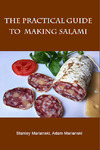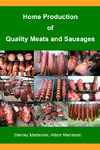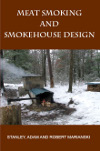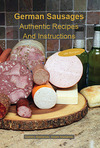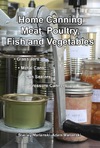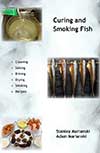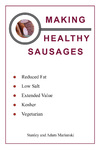Meats and Sausages
New Concepts: pH, Aw, Drying and Humidity
These new concepts are of crucial importance when making fermented sausages. They are seldom mentioned during the manufacturing of common sausages; however, they need to be understood; otherwise, one might get confused and discouraged later seeing unfamiliar words.
Acidity
Bacteria hate acidity and this fact plays an important role in the production and stabilization of fermented sausages. Increasing acidity of meat has become the main hurdle against pathogenic bacteria in sausage making; hence, understanding how to use and control it is crucial for producing microbiologically stable products. Acidic and alkaline (or "basic") are two extremes that describe substances, usually liquids or chemicals, just like hot and cold are two extremes that describe temperature. Acidity is measured in pH units.The pH Scale
The pH scale measures how acidic or alkaline a substance is. The scale ranges from 0 to 14. A pH of 7 corresponds to pure water and is neutral. A pH less than 7 is acidic, and a pH greater than 7 is basic (alkaline). The pH value of 4.6 is the division between high-acid foods and low-acid foods. Given that bacteria hate acidity, acidic foods having pH below 4.6 do not require as severe heat treatment as the ones with pH 4.6 or above. Red meats, seafood, poultry, milk, and all fresh vegetables are low-acid foods and need additional attention when being processed. This is why low-acid foods cannot be processed at 212º F (100º C) in an open water bath canner but must be processed at 240-250º F (116-121º C) in a pressure canner. Foods with a low pH value (high acidity) develop resistance against microbiological spoilage. Pickles, sauerkraut, eggs, and pig feet, submerged in vinegar will have a long shelf life. Even ordinary meat jelly (headcheese) will last longer if some vinegar is added and this type of headcheese is known as "souse". Bacteria hate acidic foods and this fact plays an important role in the production and stabilization of fermented sausages. Ideally, the pH value of meat to be used for making fermented products should be below 5.8.
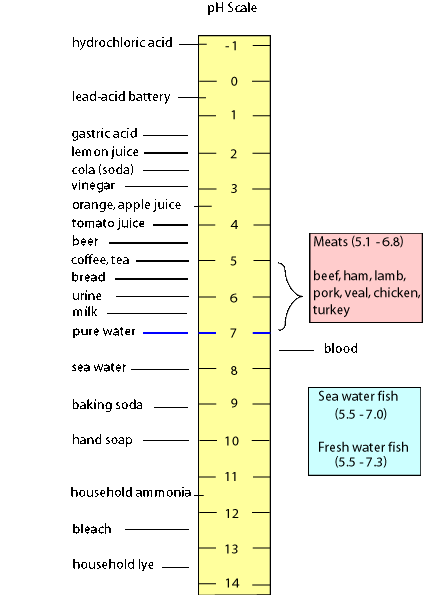
| Pork | 5.9 - 6.0 |
| Back fat | 6.2 - 7.0 |
| Emulsified pork skins | 7.3 - 7.8 |
| Beef | 5.8 |
pH is a logarithmic scale; this means that a small difference in pH, a pH of 4 is ten times more acidic than a pH of 5, a pH of 9 is ten times more alkaline (or "basic") than a pH of 8. A substance with a pH 1.0 is 1000 times more acidic than a substance with a pH 4.0. If freshly minced meat has an initial pH of 5.7 and the resulting semi-dry sausage displays a pH of 4.7, the finished sausage is 10 times more acidic, and its taste is tangy/sourly. The pH, a measure of acidity, plays a very important role in the manufacture of dry-cured, naturally fermented, or acidified products as it affects processes such as food safety, color, sliceability, drying, and even flavor. The lower the pH value, the more acidic the food, and vice versa. Acidity may be natural, as in most fruits, for example, lemon, or added, as in pickled food. Bacteria will not grow when the pH is below the minimum or above the maximum limit for a particular bacteria strain. All bacteria have their own preferred acidity level for growth, generally around neutral pH (7.0). As the pH of foods can be adjusted, this procedure becomes a potent weapon for the control of bacteria. The thermal resistance of microorganisms decreases as the pH of their medium is lowered.
Adjusting pH
Adding alkaline substances to acidic ones would decrease acidity as pH will shift lower; for example, adding water (pH 7.0) to fresh meat (pH 5.7) will shift pH to 5.8 - 6.0, depending on the amount added. However, this should be avoided as it creates favorable conditions for microorganisms to grow. Meat that we buy in a supermarket has already been "aged" (rested) in coolers from hours to days, depending on the animal, and its pH is usually around pH 5.6 - pH 5.8. at least for pork and beef. Combining pork and beef or even selecting different cuts from the same animal will produce a sausage mass of a certain pH, and the pH meat tester will display the result. As most official safety standards are based on increasing acidity to pH 5.3 and lower, we need to introduce procedures that will do just that.
The acidity in meat can be increased by:
- Fermenting meat naturally or with starter cultures. Generally, more sugar is added to meat as food for lactic acid bacteria so they can produce more acid.
- Adding acidulants such as Gdl (glucono-delta-lactone) or citric acid. Acidulants, upon contact with moisture in the meat, start the production of acid through a chemical reaction.
- Adding any substance that is more acidic than the meat, for example, lemon juice, vinegar, soy sauce, or dry wine.
pH and Meat
Bacteria prefer meats with a pH of 6.0 - 7.0, which falls near the neutral point of the pH scale. As the meat's acidity increases, the growth of bacteria becomes severely restricted. A pH drop is accomplished by lactic acid bacteria, which consume sugar and increase the meat's acidity by producing lactic acid. Foods with a low pH value (high acidity) develop resistance against microbiological spoilage. Pickles, sauerkraut, eggs, pig feet, and anything submerged in vinegar will have a long shelf life. Even ordinary meat jelly (head cheese) will last longer if some vinegar is added, and this type of head cheese is known as "souse." When buying meat marinade, look at the list of ingredients. The list invariably includes items like vinegar, dry wine, soy sauce, lemon juice, and other ingredients that are acidic or salty by nature. Although those ingredients are added mainly to tenderize meat by unwinding the protein structure, they also inhibit the growth of bacteria. A sausage can be made safe by acidity alone if its pH is 4.6 or lower, but its flavor will suffer and be very sour. To avoid this, sausages may be fermented to a higher pH but must be dried or cooked for safety reasons.
Aw - Water Activity
All microorganisms need water to live. When enough water is removed, they stop growing and die. This statement explains the science of drying foods. Water exists in meat as:
- Bound (restricted or immobilized water) - structurally associated with meat proteins, membranes, and connective tissues. This water (3-5% of the total) can only be removed by high heat and is not available for microbial activities.
- Free or bulk water - held only by weak forces such as capillary action. This free water is available for microorganisms to grow.
Below certain Aw levels, microbes cannot grow. United States Department of Agriculture guidelines state that: “A potentially hazardous food does not include . . . a food with a water activity value of 0.85 or less.” The amount of water available in a food depends on the total concentration of all dissolved substances in the product because they bind water. Thus, if ingredients such as salt, sugar, starch, flour, soy protein, non-fat dry milk are added to food, they compete with the bacteria for available water. Lower water activity inhibits the growth of spoilage and pathogenic bacteria, which is essential during the first production phase. The amount of free water and water activity can be lowered by changing the proportion of lean meat (75% of water) to fat (15% of water). The addition of more fat delivers less water to the sausage, which lowers Aw. As the sausage goes through different processing stages, it will keep on losing moisture, so its Aw will also be lower. A simple scale is used to classify foods by their water activity, and it starts at 0 (bone dry) and ends at 1 (pure water). Freshly minced meat has a very high water activity level of around 0.99, meaning that 99% of all water in meat is unbound and available since it is a breeding ground for bacteria. A meat product having Aw 0.85 indicates that only 85% of water is available for bacteria and is usually considered shelf stable as it would not support the growth of pathogenic microorganisms.
Water activity is an indication of how tightly water is "bound" inside of a product. It does not say how much water is there but how much is available to support the growth of bacteria, yeasts, or molds (fungi). Adding salt or sugar binds some of this free water inside of the product and lowers the amount of available water to bacteria which compete very poorly with salt. Molds are very good competitors for free water. We could make Aw lower by lowering the temperature of the product but that is not practical as the temperatures for making fermented sausages are well defined. A much better solution is to lower water activity by drying.
- Air drying is the process employed in lowering water activity (moisture removal) and has to be properly controlled; otherwise, it may lead to a number of defects including a total loss of product.
- During the long drying process of salami, the original hurdles lose some of their original strength. As the nitrite is depleted the number of lactic acid bacteria decreases and the pH increases (acidity decreases). This is offset by drying, which lowers water activity by removing moisture and the sausage becomes more stable in time.
- When using drying as a main safety hurdle, salami is microbiologically stable when Aw is 0.89 or lower.
- The drying chamber should not be overloaded as a uniform air draft is needed for proper drying and mold prevention.
| Water Activity (aw) of Some Foods | |
|---|---|
| Pure water | 1.00 |
| *Fresh meat & fish | 0.99 |
| Bread | 0.99 |
| *Salami | 0.87 |
| Aged cheddar | 0.85 |
| Jams and jellies | 0.80 |
| Plum pudding | 0.80 |
| Dried fruit | 0.60 |
| Biscuits | 0.30 |
| Milk powder | 0.20 |
| Instant coffee | 0.20 |
| Bone dry | 0.00 |
Common spoilage organisms and their Aw limits for growth
| Microbial Group | Example | aw | Products Affected |
| Normal bacteria | Salmonella species, Escherichia coli | 0.95-0.93 | Fresh meat, milk, animal intestinal tracts, unchlorinated water |
| Clostridium botulinum | 0.91 | Meat, soil | |
| Staph. aureus | 0.89 | Skin, red meats, poultry | |
| Normal yeast | Torulopsis species | 0.88 | Fruit juice concentrate |
| Normal molds | Aspergillus flavus | 0.80 | Jams, jellies |
| Halophilic bacteria | Wallemia sebi | 0.75 | Honey |
| Xerophilic molds | Aspergillus echimulatas | 0.65 | Flour |
| Osmophilic yeast | Saccharomyces bisporus | 0.60 | Dried fruits |
Lowering Aw
Fresh blocks of meat contain 75-80% moisture, and its water activity is Aw 0.99, out of a maximum of Aw 1.00 for pure water. Adding salt to ground meat lowers Aw immediately; the amount of drop depends on the salt level. Adding 2.5 - 3% salt to the fresh sausage mixture lowers the initial Aw 0.99 to 0.96 - 0.95, depending on the fat content in the formulation, given that fat contains less moisture than lean. During the following processing steps (fermentation, drying, cooking, drying), there will be an additional Aw drop due to the removal of water.
Fast Aw Drop
If dropping Aw is an effective safety hurdle, why not drop it as fast as possible? Well, we could add more substances that will bind water, such as non-fat milk powder, starch, flour, or gums (hydrocolloids). However, that will prevent lactic acid and flavor-forming bacteria from working, given that they need some moisture to stay alive. We won't be able to make a naturally fermented sausage.
Estimating and Measuring Aw
All factors such as pH, Aw, water moisture, and weight loss decrease in time, only salt content increases proportionally as there is less moisture, but it must be noted that the amount of salt is the same as the amount that was introduced during at the beginning of the process. Aw cannot be estimated accurately without a meter; it would be a guessing game. For example, the initial Aw of fresh pork or beef may be Aw 0.99, but the moment salt is added, the Aw can drop to 0.97 or 0.96. Generally, Aw follows the moisture curve, but the relationship is not linear. Although both water activity and moisture drop lower in time, they take different paths. Generally, it is accepted that salami reaches Aw of 0.89 when it loses around 30% of its original weight. To be shelf-stable by drying alone, Aw should drop to 0.85, which corresponds to about a 40-45% loss of its original weight. As a rule of thumb, when salami loses 33% of its original weight, it is considered safe. Needless to say, a larger diameter sausage needs more time to reach that level than a thin meat stick. In semi-dry sausages, decreasing Aw plays a secondary role, given that the safety of the sausage is obtained by a low pH, although the sausage may still be briefly dried or partially cooked.
Water Activity Meter
Measuring water activity involves more than reading pH drops and requires more expensive equipment. However, it is a must-have for commercial producers, whom meat inspectors continuously monitor. Decagon Devices Inc., presently known as Meter Group, produces Aqualab instruments, which are the fastest, most precise water activity meters available. It is unlikely that a hobbyist would use an Aw meter, but he will, instead, weigh the sausage to see how much it has lost of its original weight. This simple method has been used for centuries. When the price of the testers drops, they will become as popular as pH testers.
Drying Sausages
Drying starts from the moment a sausage is stuffed in a permeable casing and continues through fermentation, smoking, baking, ripening, drying, and storage until the sausage is consumed. Removing water content by drying a sausage is a slow process, depending on diameter; slow-fermented sausages require three months or more to be declared safe for consumption. As the process proceeds, water starts to evaporate, making meat stronger against spoilage and pathogenic bacteria. There eventually comes a point when there are no bacteria present, and the meat is microbiologically stable, provided it is stored at low temperatures and at low humidity levels. If the temperature and humidity go up, new bacteria will establish a colony on the surface, and mold may appear.
Sausages dry from inside out. For a correct drying process, there must be a balance between moisture diffusion towards the surface and moisture evaporation from the surface. If diffusion is faster than evaporation, moisture will accumulate on the surface of the sausage, causing it to be slimy. Yeasts and molds will soon follow. If evaporation is faster than diffusion, the outside surface area of the sausage will dry out and harden and will act as a barrier to subsequent moisture removal. As a result, moisture will be trapped inside the sausage, creating favorable conditions for the growth of spoilage and pathogenic bacteria. Controlled drying is a crucial procedure when making dry-cured or slow-fermented sausages, as their safety depends on the removal of moisture. It would be nice to dry a sausage quickly and be done without worrying about pH, weight loss, and other details. Well, there are basically two reasons:
- The outside layer of the sausage must not be hardened as it may prevent the removal of the remaining moisture. It may inhibit the action of the curing bacteria and the outside layer of the sausage may develop a gray ring that may be visible when slicing the sausage.
- Bacteria naturally found in meat and/or introduced starter cultures need moisture to grow. They have to go through the so-called ”lag phase” first. Only then can they metabolize sugar and produce lactic acid. Once a desired pH drop is reached, more moisture can be removed. For example, bacteria responsible for curing and flavor development are concentrated close to the surface where they easily find oxygen. They are sensitive to changing water activity levels so very fast drying can prematurely dry out the surface of the sausage.
Understanding drying is crucial when making slow-fermented, cold-smoked, or air-dried products, as the technology of making these products depends on drying.
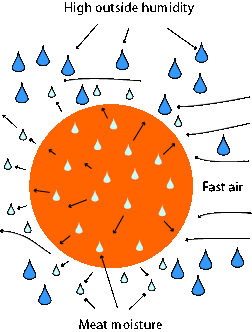
Well-balanced drying. The equilibrium state: diffusion rate = evaporation rate
The sausages are drying from the inside out; the moisture removed from the surface is replaced by the moisture coming from the inside.
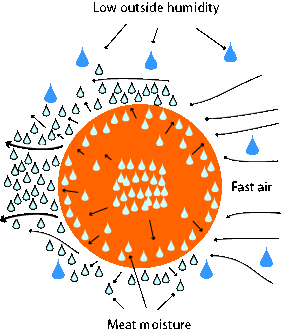
Too fast moisture removal. It is like a faster car pulling away from a slow one. Inside moisture traveling towards the surface can not keep up with the moisture removed from the surface. The sausage becomes dry on the outside and moist inside.
The pronounced effect of fast drying. The surface is dry, with a visible grayish ring on a sliced sausage. If the surface hardening occurs in the first stages of drying, the inside moisture may be permanently trapped, and bacteria will multiply, spoiling the sausage.
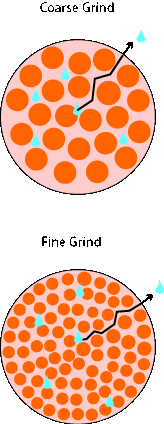
In a course grind meat, the moisture has more free room and a shorter distance to the surface. In a fine grind, the particles are very small, so moisture has to overcome more surface area on its way to the surface. The distance to the surface is longer,This problem is magnified in a large-diameter salami where moisture travels much longer. A large-diameter salami should be dried slower and longer to prevent surface hardening.
Airspeed
A continuous movement of air is needed to remove moisture from the sausage. Airspeed is a factor that helps remove moisture and stale air, and of course, it influences drying. It can be compared to the air-blower that blows away leaves on the street; however, in our case, it blows the moisture away from the surface of the sausage. Sausages will dry faster at higher temperatures; however, blowing air will remove moisture at very low temperatures, too. The best examples are Eskimos, who dry fish or seal meat in the Arctic, and Norwegians, who dry cod at freezing temperatures. People in northern countries hang laundry outside in winter, and it will dry, developing a pleasant smell and aroma. The speed of drying sausages does not remain constant, but changes throughout the process: it is fastest during the beginning of fermentation, then it slows down to a trickle. The surface of the freshly stuffed sausage contains a lot of moisture, which must be continuously removed; otherwise, slime and mold will appear.
- If the sausages are soaking wet during fermentation, the humidity should be lowered. At the beginning of fermentation, the fastest air speed is applied at about 0.8 - 1.0 m/sec. The speed of 3.6 km/h (2.2 miles/hour) corresponds to the speed of 1 meter/second which is basically a walking speed. Ideally, the amount of removed moisture should equal the amount of moisture moving to the surface.
- A medium-diameter sausage might experience 1.0-1.5% weight loss per day when in a fermenting room. The same sausage should lose about 0.5-0.7% of its weight per day when in a drying chamber.
- There is more moisture to remove from a leaner sausage given that meat contains about 75% of water and fat only ~15%. Thus a fatty sausage requires less time to dry out.
Humidity Control
Humidity, or better said, “relative humidity,” defines how much water is present in the air at a particular temperature. The air always contains some water vapor: we may not see it, but it is there, and it has a certain mass. The higher the temperature, the more water can be held by air and vice versa. Humidity changes throughout the day and is dependent upon temperature. When the temperature goes up, the humidity goes down, and vice versa. This means that there is higher humidity in the air at night when temperatures are lower. When the clouds come in and it starts to drizzle, the humidity goes up immediately. There is more humidity in areas containing lakes, rivers, or being close to the seashore than in arid areas such as deserts or mountains with less water and subsequently less humidity. This humidity behavior can be used to our advantage when a large drying chamber or smokehouse is outside. The amount of moisture in the air is fixed for at least some time, but raising the temperature lowers the relative humidity. As you cannot change the physical location of the drying chamber, you have to learn how to improvise a little:
- There are portable devices (humidifiers and dehumidifiers) that can be placed inside the drying chamber.
- In smaller chambers, such as an old refrigerator box, the most straightforward humidifier is a bowl filled with water that is placed inside. The larger the surface area of the dish, the more evaporation will take place.
- Sausages can be sprayed or immersed briefly in water to increase humidity.
- Humidity testers are inexpensive, and there is no excuse for not having one.
- In a home freezer or refrigerator, humidity varies between 40-50%.
If a cold sausage is taken out from the refrigerator and placed in a warmer area, there will be condensation water on its surface. This phenomenon is known as "the dew point" and dew point tables are available online. The condensation can be corrected by:
- Lowering the temperature in the room OR
- Reducing the humidity in the room and not changing the temperature.

